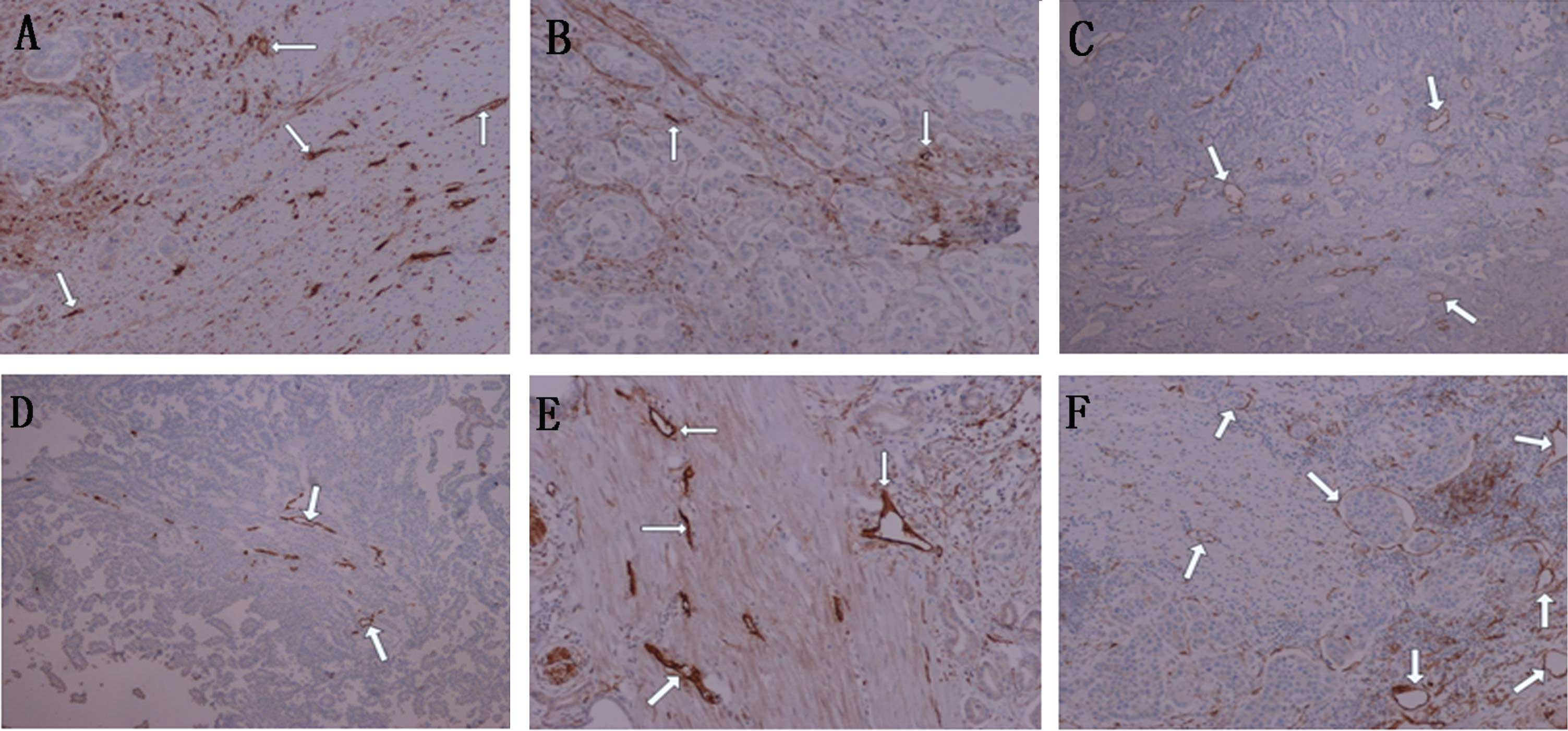Lymphangiogenesis and biological behavior in pancreatic carcinoma and other pancreatic tumors
- Authors:
- Zhongqiu Wang
- Jiang Wu
- Guojun Li
- Xinhua Zhang
- Mingmin Tong
- Zhengcan Wu
- Zhenjuan Liu
View Affiliations
Affiliations: Department of Medical Imaging, Jinling Hospital, Medical School of Nanjing University, Nanjing 210002, P.R. China, Department of Medical Imaging, Jinling Hospital, Medical School of Nanjing University, Nanjing 210002, P.R. China, Department of Head and Neck Surgery and Epidemiology, MD Anderson Cancer Center, Houston, TX 77030, USA, Department of Pathology, Jinling Hospital, Medical School of Nanjing University, Nanjing 210002, P.R. China
- Published online on: January 9, 2012 https://doi.org/10.3892/mmr.2012.745
-
Pages:
959-963
Metrics: Total
Views: 0 (Spandidos Publications: | PMC Statistics: )
Metrics: Total PDF Downloads: 0 (Spandidos Publications: | PMC Statistics: )
This article is mentioned in:
Abstract
Lymphatic vessels in primary tumor tissue play an important role in lymphatic metastasis. Lymphatic metastasis of malignant neoplasms is significantly related to prognosis, influencing both recurrence and survival. The aim of this study was to investigate the correlation of intra-tumoral lymphatic vessel density (iLVD) and peri-tumoral lymphatic vessel density (pLVD) with biological behavior and prognostic parameters in pancreatic carcinoma (PC) and other pancreatic tumors. Lymphangiogenesis was examined using the D2-40 monoclonal antibody in 33 cases of PC, 7 neuroendocrine tumors of the pancreas (NETP), 7 solid pseudopapillary tumors of the pancreas (SPTP) and 3 cystadenomas of the pancreas (CP). Positively-stained microvessels were counted at magnification x400 in dense lymphatic vascular foci (hotspots). The LVD of PC was compared to 3 other pancreatic tumors. The relationships among the LVD, the extent of differentiation, lymphatic invasion, lymph node metastasis and other clinicopathological parameters of PC were analyzed. There was no difference in the iLVD among PC, NETP, SPTP and CP. The pLVD of NETP was markedly higher than that of PC, SPTP and CP. The pLVD of PC was significantly higher than that of SPTP and CP, but there was no difference between SPTP and CP. The pLVD of PC was significantly associated with the extent of differentiation, lymphatic invasion and lymph node metastasis, whereas it was not associated with age, gender, tumor size, tumor location and peri-pancreatic invasion. The iLVD of PC was not correlated with these clinicopathological parameters. There was no difference in iLVD and no marked difference in pLVD among the pancreatic tumors. Detection of pLVD is of greater importance than detecting iLVD in these pancreatic tumors, as pLVD can be utilized for the prediction of lymph node metastasis, thus aiding in the evaluation of patient prognosis.
View References
|
1
|
MI HarrellBM IritaniA RuddellTumor-induced
sentinel lymph node lymphangiogenesis and increased lymph flow
precede melanoma metastasisAm J
Pathol170774786200710.2353/ajpath.2007.06076117255343
|
|
2
|
M RaicaAM CimpeanR CeausuD
RibattiLymphatic microvessel density, VEGF-C, and VEGFR-3
expression in different molecular types of breast cancerAnticancer
Res3117571764201121617236
|
|
3
|
NO KandemirF BarutS BektasSO OzdamarCan
lymphatic vascular density be used in determining metastatic
spreading potential of tumor in invasive ductal carcinomas?Pathol
Oncol ResJuly2011(E-pub ahead of print).
|
|
4
|
JY LinXY LiP DongT NakashimaPrognostic
value of lymphangiogenesis in supraglottic laryngeal carcinomaJ
Laryngol Otol125945951201110.1017/S002221511100151421774849
|
|
5
|
P SchulzC FischerKM DetjenAngiopoietin-2
drives lymphatic metastasis of pancreatic cancerFASEB
J2533253335201110.1096/fj.11-18228721685330
|
|
6
|
AS LeeDH KimJE LeeErythropoietin induces
lymph node lymphangiogenesis and lymph node tumor metastasisCancer
Res7145064517201110.1158/0008-5472.CAN-10-378721586615
|
|
7
|
D Klasa-MazurkiewiczM JarzabT MilczekB
LipinskaJ EmerichClinical significance of VEGFR-2 and VEGFR-3
expression in ovarian cancer patientsPol J
Pathol623140201121574104
|
|
8
|
M KozlowskiW NaumnikJ NiklinskiR MilewskiG
LapucJ LaudanskiLymphatic vessel invasion detected by the
endothelial lymphatic marker D2-40 (podoplanin) is predictive of
regional lymph node status and an independent prognostic factor in
patients with resected esophageal cancerFolia Histochem
Cytobiol499097201110.5603/FHC.2011.0013
|
|
9
|
Y KitadaiM KodamaS ChoQuantitative
analysis of lymphangiogenic markers for predicting metastasis of
human gastric carcinoma to lymph nodesInt J
Cancer115388392200510.1002/ijc.2085915688374
|
|
10
|
FT HallJL FreemanSL AsaDG JacksonNJ
BeasleyIntratumoral lymphatics and lymph node metastases in
papillary thyroid carcinomaArch Otolaryngol Head Neck
Surg129716719200310.1001/archotol.129.7.71612874070
|
|
11
|
GG Van den EyndenI van der AuweraSJ van
LaereDistinguishing blood and lymph vessel invasion in breast
cancer: a prospective immunohistochemical studyBr J
Cancer9416431649200616670715
|
|
12
|
T ArigamiS NatsugoeY UenosonoLymphatic
invasion using D2-40 monoclonal antibody and its relationship to
lymph node micrometastasis in pN0 gastric cancerBr J
Cancer93688693200510.1038/sj.bjc.660273916136051
|
|
13
|
L Rubbia-BrandtB TerrisE GiostraB DoussetP
MorelMS PepperLymphatic vessel density and vascular endothelial
growth factor-C expression correlate with malignant behavior in
human pancreatic endocrine tumorsClin Cancer
Res1069196928200410.1158/1078-0432.CCR-04-0397
|
|
14
|
B SiposM KojimaK TiemannLymphatic spread
of ductal pancreatic adenocarcinoma is independent of
lymphangiogenesisJ Pathol207301312200510.1002/path.184016161179
|
|
15
|
JM BaileyAM MohrMA HollingsworthSonic
hedgehog paracrine signaling regulates metastasis and
lymphangiogenesis in pancreatic
cancerOncogene2835133525200910.1038/onc.2009.22019633682
|
|
16
|
M SchneiderP BuchlerN GieseRole of
lymphangiogenesis and lymphangiogenic factors during pancreatic
cancer progression and lymphatic spreadInt J
Oncol28883890200616525637
|
|
17
|
Z Von MarschallA ScholzSA StackerVascular
endothelial growth factor-D induces lymphangiogenesis and lymphatic
metastasis in models of ductal pancreatic cancerInt J
Oncol27669679200516077915
|
|
18
|
MM GaidaN HaagF GuntherExpression of A
disintegrin and metalloprotease 10 in pancreatic carcinomaInt J Mol
Med26281288201020596609
|
|
19
|
GE TheodoropoulosGS PanoussopoulosNV
MichalopoulosAnalysis of the stromal cell-derived factor 1–3′A gene
polymorphism in pancreatic cancerMol Med Rep36936982010
|
|
20
|
JD ShieldsM BorsettiH RigbyLymphatic
density and metastatic spread in human malignant melanomaBr J
Cancer90693700200410.1038/sj.bjc.660157114760386
|











